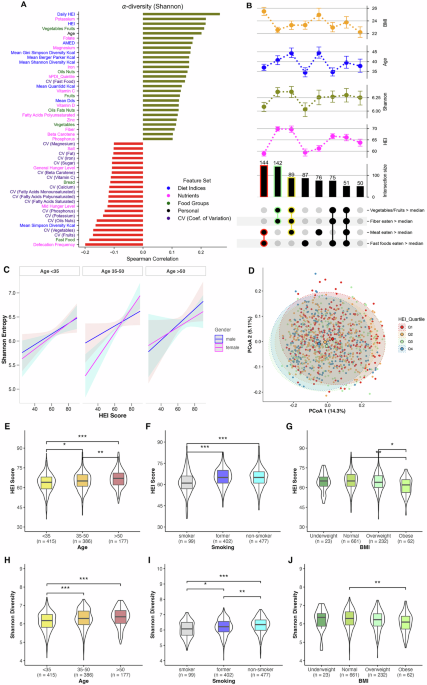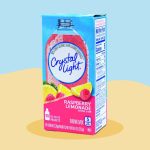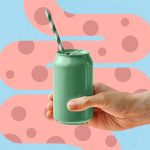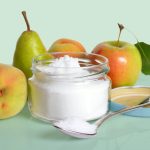It has beforehand been proven to be associated to dietary variations, significantly by way of dietary high quality and fiber consumption, throughout the pattern range of microbial species.3,11 In our research, we derived two HEI-2020 measures for every participant. “HEI”, a single rating calculated from the common day by day consumption of every meals group over all follow-up days, and the common “day by day HEI” are imply scores calculated individually day by day as a modified metric to seize day by day regularity with food plan high quality. As proven in Determine 1a, our information present a common anticipated development. Shannon Entropy 16, a measure of microbial range inside samples, was noticed to be positively correlated with HEI (Spearman r = 0.22), and is much more strongly correlated, together with day by day HEI metrics (Spearman r = 0.27), and fiber consumption (g/day), vegetable footfruit content material (G/day), and microorganisms reminiscent of microorganisms reminiscent of microorganisms. (mg/day), folic acid (µg/day) and iron (mg/day) (Fig. 1a). Comparable correlation patterns have been noticed throughout different alpha range metrics, together with Pielou uniformity, Religion’s PD, and noticed options (Supplementary Fig. 1b). Conversely, unhealthy dietary intakes reminiscent of quick meals (G/day) and salt (G/day) content material confirmed a adverse correlation with microbial alpha range (Fig. 1A). Moreover, a optimistic correlation with age was noticed, with vital variations in food plan high quality and alpha range between youthful and older teams (Fig. 1E, H).
Evaluation of members grouped by median consumption for various meals teams (G/day) revealed totally different patterns (Determine 1B). Contributors with vegetable fruit and fiber consumption above median (n = 142) confirmed prime quality HEI diets, excessive range in Shannon and low BMI. In distinction, these with larger meat and quick meals consumption (n = 144) than median meat confirmed considerably larger BMI and HEI and Shannon range. Contributors who consumed vegetable fruit, meat and fiber above the median stage (n = 89) confirmed the best Shannon range together with very excessive HEI scores, older age, and decrease BMI. These with larger quick meals consumption (n = 87) confirmed decrease HEI scores and Shannon range, primarily youthful.
A number of regression analyses incorporating potential interactions revealed that HEI considerably predicted Shannon entropy (β=0.035, 95% CI (0.0008, 0.0213)) unbiased of age and gender. The connection between HEI and Shannon’s entropy remained constant throughout age teams and gender (Determine 1C). Specifically, the regression mannequin additionally revealed that BMI had a big impact on microbial range in overweight people (β= –0.1891, P=0.005, 95% CI (–0.3208, –0.0528)) and in chubby people (β=–0.10, P=0.011, 95% CI (–0.0.1924,) (–0.3208, –0.0528)). Shannon entropy is decrease in comparison with these with regular BMI. Moreover, they’ve concurrently poor HEI in comparison with day by day defecation frequency (β=-0.137, Pβ=-0.1210, P=0.0004, 95% CI (–0.2888,–0.0692)) and former people who smoke (β=-0.1789, P=0.0016), 95% CI (–0.1876,–0544) nonsmokers (Determine 1F, I).
Moreover, when becoming the mannequin utilizing day by day HEI as a substitute of an everyday HEI rating (age and BMI as steady variables, no interplay terminology), day by day HEI stays an important predictor of Shannon entropy (β=0.019, p3), reflecting a fair stronger impact of normal HEI coefficients than P of P reveals.
Actual-time monitoring by way of the MyFoodRepo app allowed us to gather non permanent food plan information over a number of days, permitting us to calculate metrics that might assess temporal variation in consumption of various dietary content material throughout members’ monitoring dates. This variability is expressed by way of CV. This means that larger values end in larger irregularities in consumption. In Determine 1a, we discover that resumes of varied dietary traits reminiscent of fruits, greens, oil fields, monolayers and polyunsaturated fat, and the aforementioned micronutrients are negatively correlated with intestine microbiota range. Moreover, absolutely the values of the correlations of those options have been typically extra variable than the respective consumption. This means that the excessive variability in consumption in these meals teams can be utilized as a metric, maybe higher metric for particular dietary traits, to measure the results of food plan on Shannon’s range. This relationship between CV and intestinal range persevered even when controlling for complete consumption by means of layered evaluation (see Supplementary part for detailed verification).
Moreover, multivariate regression fashions have been used to look at the extent of variance defined by the dietary variables of Shannon alpha range (Supplementary Fig. 1). It was noticed that macronutrients alone (i.e. carbohydrates, protein, fat, fiber, alcohol) defined about 5% dispersion, whereas micronutrients defined a lot of the dispersion, and practically 10%. Collectively, micronutrients, macronutrients, dietary indexes, and meals teams defined practically 20% of the variance in alpha range. Earlier research counsel that food plan accounts for about 5% to twenty% of the dispersion of microbiome composition17. Correspondingly, the first coordinate evaluation for non-weight UnifrAC distances (i.e., distance metrics measuring between samples based mostly on phylogenetics, i.e., beta range) revealed that roughly 20% of the variance was defined on the first two essential coordinates (proven in Fig. 1D), however cluster separations didn’t differ considerably for both isoparticle. Nonetheless, contemplating the 2 extremes of the Hei quartiles (Q1 and This autumn), the best HEI quartiles (This autumn) have been characterised by a considerably larger consumption of greens and fruits. In distinction, the bottom HEI quartile (Q1) confirmed excessive consumption of quick meals and sweets + salty snacks + alcoholic meals teams (Supplementary Fig. 1C).
Moreover, we calculated the impact sizes for varied demographic and dietary traits (Cohen’s F for multicategorical variables and Cohen’s D for binary variables) utilizing the plain Package18. Within the case of Shannon’s range, HEI had a serious influence. Pairwise impact sizes are additionally calculated for options which might be already binary, and normally characterize the highest and backside quartiles inside a non-binary operate by subsetting the info into two excessive teams. For pairwise, the Hei quartiles (Q1 vs This autumn), age group (18–35 vs 65+), HPDI Quintiles and BMI classes (i.e. regular vs weight problems) confirmed massive impact sizes. Nonetheless, solely previous antibiotic remedies and menopause standing have been vital within the beta range metric.
Moreover, partial correlation evaluation was carried out to research which microbial species correlate effectively with totally different meals teams and macronutrients, and saved age and BMI as covariates (Fig. 2A). Most microorganisms that have been positively correlated with HEI and have been effectively correlated with micronutrients reminiscent of fiber, vegetable, fruit, nut content material and potassium, have been additionally primarily from the taxonomic lacnospirales. Determine 2a reveals a few of these taxa, significantly productions reminiscent of Lacnospira (ASVS 55, 137), Eubacterium (ASVS 73, 222), Brotafodocola (ASV 25), Aritiskatomonas (ASV 74), and Muricoprocola (ASV 228), egs with corres with Correlation with Correlation one comers for sec and ASV 73 and 137. This is smart as a fiber-rich food plan will increase SCFA manufacturing within the gut, and is primarily related to butyrate merchandise. These micro organism contribute to more healthy outcomes, primarily because of the useful position of SCFA. Curiously, some non-lacnospirales micro organism have been additionally correlated with HEI and associated meals traits. These included ASVs from order oscillospirals reminiscent of ASV 51 (Dysosmobacter) and ASVs from Christensenellales (ASV 100). Many taxa belonging to genus reminiscent of Mediterraneibacter (ASV 136) Lawsonibacter (ASV 134) have been related to elevated meat consumption. Many different taxa correlated positively with quick meals consumption and CV variables reminiscent of CVOil-Nuts and CVFruits, and negatively correlated with fiber and HEI index. These embrace taxa reminiscent of ASV 386 (genus Negativibacillus), ASV 380 (genus Merdibacter), ASV 370 (genus Acutalibacter) and ASV 360 (genus Thomasclavelia).
ASV 73 (genus Eubacterium_j) is widespread in ~80% microbiome samples and was strongly related to wholesome consumption consumption because it correlates with HEI, fiber, oil nut seeds, greens and fruits. Once more, evaluating the highest and backside quartiles and backside quartiles of HEIs between people (This autumn and Q1, respectively), there’s a vital distinction in that the median CLR abundance for the highest quartile was a lot larger than the median CLR abundance for the underside quartiles of those meals teams (Fig. 2B). For the meat, quick meals, sweets + salty snacks + alcohol and bread meals teams, the median CLR abundance for the This autumn (prime) quartiles in these meals teams was decrease than the respective backside quartiles. One other ASV with a big presence in individuals who eat massive quantities of those wholesome meals teams was ASV 100, however its presence was very low in individuals who eat extra meat and quick meals (Determine 2C). Nonetheless, contrasting correlations have been discovered for ASV 37 (genus Dysossosmobacter), which has a better correlation with the irregular consumption of meat and greens, fruits and oil nuts. Its prevalence was about 90%, with median CLRs being larger in quartiles for more healthy meals teams (Fig. 2D). This means that these micro organism are widespread in poor diets, however will not be very plentiful in people who eat extra vegetarian or more healthy diets. Research have proven that these micro organism are related to optimistic MICE19 well being results19. Nonetheless, in our cohort, they have been negatively correlated with the HEI index.
Log ratios have been calculated from differentially wealthy taxa (prime 100) recognized utilizing Birdman, throughout dietary variables. The logarithmic ratio correlation reveals sturdy complementarity with every dietary variable and different associated variables, however contrasting patterns are seen with variables negatively related to the corresponding dietary variable, as proven in Determine 3E. For instance, the log ratio of HEI (log ratio) is strongly positively related to HEI (r = 0.42, pr = −0.27, p3a, B. Equally, the dietary irregularity variables, i.e., IE,CV, are inversely correlated with the log ratios of varied meals, reminiscent of vegetable teams, fiber nut, fiferis, fiferis, fifer gruts group, fifer nut, fifer gruts group, fifer nut, fifer gruts group, fiber nut, fifer gruts group, fiber nut, fifer gruts group, fiber nut, fifer gruts group, fiber nut, fifer gruts group, fiber nut, fiver fation, and many others. The affiliation with different geographic cohorts reveals, for instance, Supplementary Fig. 1d,E). Mexico: r = 0.12).
Determine 3D highlights the affiliation between dietary content material and differentially wealthy intestine microbial taxa at classification stage. Vitamins analyzed embrace meals teams reminiscent of HEI, fiber, fruits, greens, power consumption (KCAL/day), meat, quick meals, bread, espresso, and alcohol. CV for fruit and potassium. Intestinal bacterial communities throughout the community have been primarily represented by Clostridia. Wholesome dietary elements (e.g. HEI, fiber, fruits, greens) confirmed related correlation patterns, displaying adverse associations (magenta edges) and optimistic associations (cyan edges) with particular bacterial taxa and different bacterial taxa. HEI emerged as an necessary issue with many connections, reflecting the sturdy affiliation with microbiota composition amongst differentially wealthy taxa.
Birdman evaluation recognized a number of taxa with sturdy optimistic and adverse associations with day by day HEI scores (Determine 3F). Damaging affiliation was proven together with members of a number of taxa (ASV 37 and 337) and Lawsonibacter (ASV 37 and 134) within the Mediterranaibacter genus (ASV 136, 268, and 36) and Lawsonibacter (ASV 377 and 134) because it reveals a lower in log-mean vary with elevated day by day HEI scores. These taxa have been much less plentiful in people with larger scores. Conversely, taxa displaying optimistic associations embrace a number of family members Eubacterium and a number of taxa of the genus Eubacterium_J (ASV 222 and 73), Butyribacter (ASV 259), and Coprococcus A_121497 (ASVS 330, 202) associated to the chance that they could be related to sufferers who could also be related to sufferers. Rating. Curiously, Rosebria_a_166204 had a differentially wealthy taxa, each adverse (ASVs 32 and 156) and optimistic (ASVs 343 and 238). Completely different presence analyses have been carried out equally for different dietary variables (Supplementary Fig. 4).
Given the beforehand reported associations between food plan, life-style and well being outcomes, our information additional examined whether or not machine studying fashions may predict dietary and life-style components utilizing solely the microbiota as function inputs. As a classification job utilizing the XGBoost classifier mannequin, we investigated the variations in excessive quartiles (Q1 vs. This autumn) for dietary traits. Determine 4A and Supplementary Determine 3C present that plant fruit and occasional consumption within the meals group, in addition to day by day HEI regularity, may be strongly predicted with AUROC and AUPRC values round 0.9. Equally, this predictive energy for the consumption of oil nuts within the fiber and meals group, and the usual HEI food plan index will also be noticed. All of this reveals values for AUROC and AUPRC round 0.85-0.9 (Fig. 4A and Supplementary Fig. 3C). Moreover, Cvoils-Nuts, meat consumption, folic acid consumption, quick meals consumption, grain potato pulse, vitamin C, and dietary method (DASH) food plan index to cease hypertension was additionally strongly predictable, with ROC AUC values round 0.75-0.85. Age teams (18-35 and >50 years), BMI classes (regular versus weight problems), and Swiss language domains (German and Latin) have been additionally predictable from microbiota traits.
We then examined the efficiency of the regressor mannequin utilizing all the dataset, not simply the intense quartiles used for the classifier. The patterns noticed within the regressor mannequin carefully mirror what’s seen in classifier outcomes (Fig. 4B). Particularly, day by day HEI and vegetable fruit consumption reveals the best Spearman correlation worth near 0.5. Nonetheless, it’s noteworthy that the predictive energy of CVFruits was larger than the predictive energy of consumed fruits in each the classifier and regressor fashions. The identical sample is noticed in day by day HEI and normal HEI food plan indexes. Right here, regularity metrics are superior to plain metrics. We additionally reversed the prediction course and used dietary and anthropometric options to categorise excessive quartiles of alpha range metrics. Religion’s PD confirmed the best predictability (median ROC AUC ~0.75), as proven in Supplementary Fig. 3a, adopted by Shannon’s range and richness (variety of noticed microbiota options). In different phrases, microbial composition strongly predicts dietary patterns. This has additionally been demonstrated in a current research 8,21, however dietary patterns present sturdy anti-directional predictive energy regardless of being barely decrease.
Evaluation of the significance of the traits of the best-performing dietary classifiers (HEI, vegetable fruit, oil nuts, espresso, meat) revealed shared predictive taxa (Fig. 4C). Members of the Lachnospiraceae household, significantly Eubacterium, Lachnospira, and Butyribacter, have been necessary predictors of HEI, vegetable fruits, and oil nuts. For meat consumption, key predictors embrace Mediterraneabacter and Coprococcus (Younger Nospiraceae), Blauti, Negatibibacillus (Luminococcus household), a number of bacilli, Bilophylla, and Allisonra genus. Espresso consumption was greatest predicted by Lawson Bacter, reptile fungi, and members of Coliobacteria and Bacteroids.
Predicting alpha range metrics from dietary and life-style components, day by day HEI emerged as essentially the most highly effective predictor for all 4 range metrics, adopted by age and potassium consumption (Supplementary Fig. 3B). Specifically, some metrics of dietary variability (CV) have been ranked in CVs, significantly greens, HEI, and fruit resumes, significantly CVs. The salience of those CV capabilities in predicting alpha range gives unbiased help for the commentary that each dietary high quality and its temporal consistency play an necessary position within the formation of intestinal microbiome composition.
Within the “Meals & You” cohort, members accomplished a day by day survey that included an non-compulsory stool high quality report, with 140 members reporting for at the very least 5 days. Stool high quality was normally categorised as nice, constipation, or diarrhea. Two traits have been derived: the big stool charge, the proportion of reported days, is the proportion of reported days, which signifies the proportion of days reported as diarrhea.
Determine 5a reveals components correlated with massive stool charges. Espresso consumption confirmed the strongest optimistic correlation, adopted by dairy merchandise, imply dietary range rating (DDS), and cubachol, with Spearman correlations starting from r = 0.2 to 0.3. Particular micronutrients (e.g. calcium, phosphorus, folic acid), saturated fatty acids and dietary index (HEI and dietary Shannon range) confirmed a optimistic correlation between r = 0.15 and r = 0.2. Candy and quick meals confirmed adverse correlations (r = -0.22 and r = -0.15, respectively). A number of CV components, together with CVDAIRY, CVPhosphorus, CVFRUITS, CVCALCIUM, and CVOILS-NUTS, have been negatively correlated with glorious stool high quality. Life-style components reminiscent of stress ranges, display time, and sleep issues additionally confirmed adverse correlations. Specifically, in lots of dietary options, the correlation between irregularity and huge stool was stronger than the quantity of operate.
For the proportion of diarrhea (Determine 5B), irregular intakes of various meals teams and vitamins (Cvoils-nuts, cvphosphorus, cvpotassium, cvgrains-Cereals, cvniacin) confirmed a optimistic affiliation. Defecation frequency, menstrual cycle range, and common starvation ranges have been additionally positively correlated with the speed of diarrhea. Micronutrient consumption (for magnesium, iron, potassium, phosphorus, zinc, calcium) and polyunsaturated fatty acids confirmed adverse correlations (r = -0.15 to -0.28). Dietary indices together with imply DD, HEI, and variety scores for Zinni Simpson have been additionally negatively correlated with the proportion of diarrhea.
Customers have been categorized based mostly on the stool high quality proportion. High 50 customers of the best high quality, prime 20 customers with the best charge of constipation and diarrhea, respectively, constipation and diarrhea, respectively, as normal. Customers with glorious stool high quality confirmed a better incidence of excessive HEI quartiles This autumn and Q3 (Determine 5F), whereas diarrhea customers confirmed reverse traits (Determine 5G) and low Shannon Alpha range (Determine 5D). Constipation customers confirmed no linear traits in HEI. Most customers have above common (Q3) or poor food plan high quality.
Partial correlation evaluation controlling for age and BMI revealed an affiliation between microbial taxa and diarrhea charges (Fig. 5I). Genes 165 and 31) containing Mediterraneibacter_a_155507 (ASV 136), Phascolarctobacterium_a (ASV 183), Acetatifactor (ASV 516 and 270), Bacteroides_H (ASV 340), Lawsonibacter (ASV 1352), Dysosmobacter (ASV_152), and asv152) confirmed the best optimistic correlation. Conversely, ASVs comparable to Bifidobacterium_388775 (ASV 99), Bacteroides_H (ASV 124), Coprococcus_A_187866 (ASV 92), and Collinsella (ASVS 104 and 26) confirmed a weakly adverse correlation (R = -0.2).









